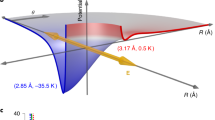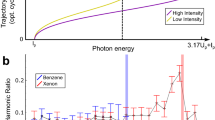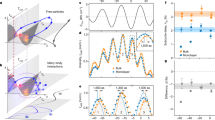Abstract
The concerted motion of two or more bound electrons governs atomic1 and molecular2,3 non-equilibrium processes including chemical reactions, and hence there is much interest in developing a detailed understanding of such electron dynamics in the quantum regime. However, there is no exact solution for the quantum three-body problem, and as a result even the minimal system of two active electrons and a nucleus is analytically intractable4. This makes experimental measurements of the dynamics of two bound and correlated electrons, as found in the helium atom, an attractive prospect. However, although the motion of single active electrons and holes has been observed with attosecond time resolution5,6,7, comparable experiments on two-electron motion have so far remained out of reach. Here we show that a correlated two-electron wave packet can be reconstructed from a 1.2-femtosecond quantum beat among low-lying doubly excited states in helium. The beat appears in attosecond transient-absorption spectra5,7,8,9 measured with unprecedentedly high spectral resolution and in the presence of an intensity-tunable visible laser field. We tune the coupling10,11,12 between the two low-lying quantum states by adjusting the visible laser intensity, and use the Fano resonance as a phase-sensitive quantum interferometer13 to achieve coherent control of the two correlated electrons. Given the excellent agreement with large-scale quantum-mechanical calculations for the helium atom, we anticipate that multidimensional spectroscopy experiments of the type we report here will provide benchmark data for testing fundamental few-body quantum dynamics theory in more complex systems. They might also provide a route to the site-specific measurement and control of metastable electronic transition states that are at the heart of fundamental chemical reactions.
This is a preview of subscription content, access via your institution
Access options
Subscribe to this journal
Receive 51 print issues and online access
$199.00 per year
only $3.90 per issue
Buy this article
- Purchase on Springer Link
- Instant access to full article PDF
Prices may be subject to local taxes which are calculated during checkout




Similar content being viewed by others
References
Pisharody, S. N. & Jones, R. R. Probing two-electron dynamics of an atom. Science 303, 813–815 (2004)
Vanroose, W., Martin, F., Rescigno, T. N. & McCurdy, C. W. Complete photo-induced breakup of the H2 molecule as a probe of molecular electron correlation. Science 310, 1787–1789 (2005)
Remacle, F. & Levine, R. D. An electronic time scale in chemistry. Proc. Natl Acad. Sci. USA 103, 6793–6798 (2006)
Lin, C. D. Hyperspherical coordinate approach to atomic and other Coulombic three-body systems. Phys. Rep. 257, 1–83 (1995)
Goulielmakis, E. et al. Real-time observation of valence electron motion. Nature 466, 739–743 (2010)
Mauritsson, J. et al. Attosecond electron spectroscopy using a novel interferometric pump-probe technique. Phys. Rev. Lett. 105, 053001 (2010)
Holler, M., Schapper, F., Gallmann, L. & Keller, U. Attosecond electron wave-packet interference observed by transient absorption. Phys. Rev. Lett. 106, 123601 (2011)
Loh, Z. H., Greene, C. H. & Leone, S. R. Femtosecond induced transparency and absorption in the extreme ultraviolet by coherent coupling of the He 2s2p (1Po) and 2p2 (1Se) double excitation states with 800 nm light. Chem. Phys. 350, 7–13 (2008)
Wang, H. et al. Attosecond time-resolved autoionization of argon. Phys. Rev. Lett. 105, 143002 (2010)
Lambropoulos, P. & Zoller, P. Autoionizing states in strong laser fields. Phys. Rev. A 24, 379–397 (1981)
Themelis, S. I., Lambropoulos, P. & Meyer, M. Ionization dynamics in double resonance involving autoionizing states in helium: the effect of pulse shapes. J. Phys. B 37, 4281–4293 (2004)
Chu, W. C., Zhao, S. F. & Lin, C. D. Laser-assisted-autoionization dynamics of helium resonances with single attosecond pulses. Phys. Rev. A 84, 033426 (2011)
Ott, C. et al. Lorentz meets Fano in spectral line shapes: a universal phase and its laser control. Science 340, 716–720 (2013)
Meyer, H. D., Manthe, U. & Cederbaum, L. S. The multi-configurational time-dependent Hartree approach. Chem. Phys. Lett. 165, 73–78 (1990)
Schulz, K. et al. Observation of new Rydberg series and resonances in doubly excited helium at ultrahigh resolution. Phys. Rev. Lett. 77, 3086–3089 (1996)
Beutler, H. Über Absorptionsserien von Argon, Krypton und Xenon zu Termen zwischen den beiden Ionisierungsgrenzen 2P32/0 und 2P12/0. Z. Phys. A 93, 177–196 (1935)
Fano, U. Effects of configuration interaction on intensities and phase shifts. Phys. Rev. 124, 1866–1878 (1961)
Gilbertson, S. et al. Monitoring and controlling the electron dynamics in helium with isolated attosecond pulses. Phys. Rev. Lett. 105, 263003 (2010)
Argenti, L. & Lindroth, E. Ionization branching ratio control with a resonance attosecond clock. Phys. Rev. Lett. 105, 053002 (2010)
Pollard, W. T. & Mathies, R. A. Analysis of femtosecond dynamic absorption-spectra of nonstationary states. Annu. Rev. Phys. Chem. 43, 497–523 (1992)
Rost, J. M., Schulz, K., Domke, M. & Kaindl, G. Resonance parameters of photo doubly excited helium. J. Phys. B 30, 4663–4694 (1997)
Reinhardt, W. P. Complex coordinates in the theory of atomic and molecular-structure and dynamics. Annu. Rev. Phys. Chem. 33, 223–255 (1982)
Paul, P. M. et al. Observation of a train of attosecond pulses from high harmonic generation. Science 292, 1689–1692 (2001)
Kim, K. T. et al. Amplitude and phase reconstruction of electron wave packets for probing ultrafast photoionization dynamics. Phys. Rev. Lett. 108, 093001 (2012)
Ullrich, J. et al. Recoil-ion and electron momentum spectroscopy: reaction-microscopes. Rep. Prog. Phys. 66, 1463 (2003)
Morishita, T., Watanabe, S. & Lin, C. D. Attosecond light pulses for probing two-electron dynamics of helium in the time domain. Phys. Rev. Lett. 98, 083003 (2007)
Palaudoux, J. et al. Multielectron spectroscopy: Auger decays of the krypton 3d hole. Phys. Rev. A 82, 043419 (2010)
Augst, S., Meyerhofer, D. D., Strickland, D. & Chin, S. L. Laser ionization of noble-gases by Coulomb-barrier suppression. J. Opt. Soc. Am. B 8, 858–867 (1991)
Assion, A. et al. Control of chemical reactions by feedback-optimized phase-shaped femtosecond laser pulses. Science 282, 919–922 (1998)
Krausz, F. & Ivanov, M. Attosecond physics. Rev. Mod. Phys. 81, 163–234 (2009)
Henke, B., Gullikson, E. & Davis, J. X-ray interactions: photoabsorption, scattering, transmission, and reflection at E = 50–30,000 eV, Z = 1–92. At. Data Nucl. Data Tabl. 54, 181–342 (1993)
Domke, M., Schulz, K., Remmers, G., Kaindl, G. & Wintgen, D. High-resolution study of 1Po double-excitation states in helium. Phys. Rev. A 53, 1424–1438 (1996)
Santra, R., Yakovlev, V. S., Pfeifer, T. & Loh, Z.-H. Theory of attosecond transient absorption spectroscopy of strong-field-generated ions. Phys. Rev. A 83, 033405 (2011)
Samson, J. A. R., He, Z. X., Yin, L. & Haddad, G. N. Precision measurements of the absolute photoionization cross-sections of He. J. Phys. B 27, 887 (1994)
Hicks, P. J. & Comer, J. Ejected electron spectroscopy of autoionizing states excited by low energy electron impact. J. Phys. B 8, 1866 (1975)
Bürgers, A., Wintgen, D. & Rost, J.-M. Highly doubly excited S states of the helium atom. J. Phys. B 28, 3163–3183 (1995)
Argenti, L. & Moccia, R. K-matrix method with B-splines: sigma (nl), beta(n) and resonances in He photoionization below N = 4 threshold. J. Phys. B 39, 2773–2790 (2006)
Argenti, L. & Moccia, R. Helium 2(3)S photoionization up to the N = 5 threshold. J. Phys. B 41, 035002 (2008)
Acknowledgements
We thank E. Lindroth for calculating the dipole moment 〈2p2|r|sp2,3+〉, and A. Voitkiv, Z.-H. Loh and R. Moshammer for discussions. We acknowledge financial support from the Max Planck Research Group Program of the Max Planck Gesellschaft (MPG), the Deutsche Forschungsgemeinschaft (grant no. PF 790/1-1) and the European COST Action CM1204 XLIC. L.A. and F.M. acknowledge computer time from the CCC-UAM and Mare Nostrum supercomputer centres and financial support from the European Research Council under the ERC Advanced Grant no. 290853 XCHEM; the Ministerio de Economía y Competitividad projects FIS2010-15127, FIS2013-42002-R and ERA-Chemistry PIM2010EEC-00751; and the European grant MC-ITN CORINF.
Author information
Authors and Affiliations
Contributions
C.O. and T.P. designed the experiment. C.O., A.K., P.R., R.H. and T.P. built the experimental apparatus. C.O., A.K., Y.Z., P.R. and T.P. conducted the experiments. C.O., A.K., S.H., R.H. and T.P. performed the experimental data analysis and interpretation, C.O., A.K., S.H., T.D., R.H. and T.P. carried out the few-level model simulation. L.A. designed and implemented the ab initio methods. L.A. and F.M. carried out the ab initio simulation and significantly contributed to the interpretation of the results. J.M. calculated the field-free wave functions. C.O., A.K., L.A., F.M. and T.P. wrote major parts of the manuscript. All authors contributed to the discussion of the results and commented on the manuscript.
Corresponding authors
Ethics declarations
Competing interests
The authors declare no competing financial interests.
Extended data figures and tables
Extended Data Figure 1 Experimental apparatus and recorded data.
a, Design view of the experimental set-up, consisting of a neon (Ne) gas target for high-harmonic generation (HHG), a motorized iris aperture, a split mirror (SM) in combination with a thin silicon nitride (Si3N4) membrane and an aluminium (Al) filter, a focusing toroidal mirror (TM), a dense (∼100 mbar) absorbing helium (He) target, and a home-built high-resolution spectrometer, which consists of a variable-line-spacing (VLS) grating, a cooled (−50 °C) XUV CCD camera, and a pair of Al filters for stray-light suppression. b, Recorded XUV reference spectrum (black line; no He gas in target cell) in the 50–70 eV energy range, averaged over ∼64,000 laser shots, and recorded XUV signal spectrum after transmission through the dense He gas target (red line), averaged over ∼640,000 laser shots. The statistical error is of the order of the line thickness. c, Two-dimensional absorbance at a calibrated VIS peak intensity of 3.3 × 1012 W cm−2. The plot consist of 300 single absorbance spectra (for details and definition, see ‘Experimental data acquisition’ in Methods), that were obtained with a time-delay step size of ∼170 as.
Extended Data Figure 2 Few-level model simulation details.
a, Level scheme of the simulated subsystem, including the ground state |g〉 ≡ |1s2〉, the autoionizing bound states |a〉 ≡ |2s2p〉, |b〉 ≡ |2p2〉 and |c〉 ≡ |sp2,3+〉, and the continua |1s, εp〉 and |1s, εs〉, all coupled via the dipole matrix elements dnm as depicted. The configuration-interaction matrix elements Vε,n couple the excited states with their corresponding (symmetry 1Po or 1Se) continua. b, Schrödinger equation describing the temporal evolution of the coupled states’ expansion coefficients cn(t), resulting from the respective coupling pathways depicted in a. Further explanations and definitions of parameters are given in ‘Few-level model simulation’ in Methods. c, Simulated two-dimensional absorbance plot of the few-level system assuming a quasi-monochromatic VIS field of 730 nm wavelength. The absorbance spectra were temporally averaged over one VIS laser cycle (XUV/VIS delay), and convolved with the experimental detector resolution (σ = 20 meV). d–f, Simulated temporal evolution of |cn(t)| of the three autoionizing states 2s2p (1Po; black lines), 2p2 (1Se; blue lines) and sp2,3+ (1Po; red lines) where the 1Po-symmetry states were weakly populated by an XUV attosecond pulse at time t = 0 fs. All states were coupled by a VIS pulse (7 fs, 730 nm, 3 × 1012 W cm−2) at three different time delays τ. The dashed curves show the states’ evolution in the absence of the VIS field.
Extended Data Figure 3 Intensity calibration of the experimental data.
a, Calculated absorbance for a 7 fs, ∼730 nm VIS laser pulse at increasing intensity. b, Experimentally measured absorbance for increasing openings of the iris diaphragm. For a and b, the time delay was set to where the Autler–Townes splitting is at maximum, averaged over two modulation periods. c, The comparison of maximum absorbance of the left-shifting 2s2p line (starting from 60.15 eV) between numerical and experimental results yields an in situ mapping between the VIS intensity and the iris opening in the experiment (black line). The grey shaded area denotes the standard deviation, taking into account different VIS durations and an additional comparison near 0 fs time delay, and thus represents the systematic uncertainty of the monotonically increasing intensity-calibration curve.
Extended Data Figure 4 Effects of the attosecond pulse configuration and the carrier envelope phase.
a, Simulated absorbance plots (top) for different XUV pulse configurations: two attosecond pulses, φCEP = π/2 (left); one attosecond pulse, φCEP = 0 (middle); one attosecond pulse, φCEP = π/2 (right). The VIS pulse duration was 7 fs with 3 × 1012 W cm−2 peak intensity, where the respective XUV/VIS pulse configurations are illustrated at zero time delay (bottom). b, Experimentally measured absorbance plots for CEP stabilization (top left; with root mean squared residual statistical noise of 0.38 rad) and CEP non-stabilization (top right). The observed time-dependent features, including the lineout at photon energy 63.66 eV (bottom) are practically identical for the CEP-stabilized and the non-CEP-stabilized measurements. Any significant temporal jitter between the attosecond pulses and the VIS carrier wave in the HHG process, for the case of statistical CEP, would correspond approximately to an averaging over a range of time delays for the case of a CEP-stable measurement, smearing out subcycle oscillations in the absorbance. This is clearly not observed.
Extended Data Figure 5 Simulated absorbance changes (ΔA) for low VIS intensity and different pulse configurations.
a, One attosecond pulse, φCEP = 0. b, One attosecond pulse, φCEP = π/2. c, Two attosecond pulses, φCEP = 0. d, Two attosecond pulses, φCEP = π/2. e, Multiple attosecond pulses (pulse train), φCEP = 0. f, Multiple attosecond pulses (pulse train), φCEP = π/2. The lower plots in a–f show the respective pulse configurations at zero time delay. The VIS pulse duration was 7 fs and the intensity was 3 × 1010 W cm−2. g, h, Power spectral density distribution of the ΔA oscillation of the experiment (g) and the simulation (h). The frequency range used in the analysis is marked in red. We used the full modulation bandwidth, via filtering from near-zero frequency up to the Nyquist frequency, to retrieve the phase φA(τ).
Extended Data Figure 6 Reconstruction of the wave packet from time-delay-dependent ΔA(τ) data near the sp2,3+ resonance at 63.67 eV (simulation results).
a, ΔA(τ) for the different excitation scenarios shown in Extended Data Fig. 5. b, The phase φA(τ) extracted from the ΔA(τ) oscillations (solid lines), compared with the phase φ(t) of the wave packet (dashed lines) for the different excitation configurations. c, The difference between the (measurable) modulation phase φA(τ) and the wave-packet phase φ(t) for each of the excitation scenarios. A time-delay-dependent correction phase of ∼0.4π needs to be taken into account to reconstruct the wave-packet phase φ(t) in the experiment from the measured ΔA(τ), as shown in Fig. 2. d, The variation in the wave-packet amplitude ratio for the different excitation configurations. Even in the extreme case of multiple attosecond pulses, the amplitude ratio is well defined within a region of ±10%.
Extended Data Figure 7 Fitting the intensity-dependent spectral line shapes of the 2s2p and the sp2,3+ resonances.
a, b, Least-squares fit to the experimentally measured line shape shown in Fig. 4a. The laser-controlled line shape is shown for several laser intensities as given in the figure. Error bars here and phase error in Fig. 4c, d correspond to s.d. obtained by analysing at three values of τ = 5.35 fs, τ = 4.15 fs, τ = 6.55 fs. c, d, Least-squares fit to the theoretically predicted line shape obtained from the ab initio simulation results shown in Fig. 4b, also plotted for several laser intensities as denoted in the figure. In all cases, the restricted energy region of the least-squares fit (2s2p, 60.11–60.21 eV (a, c); sp2,3+, 63.56–63.76 eV (b, d)) ensures phase retrieval for times after the interaction with the laser pulse.
Supplementary information
Measured transient absorption data for various VIS laser intensities
The VIS intensity is increasing throughout the video, and given in W/cm2 as stated in the upper left area. The corresponding electric field strength is printed in atomic units (a.u.). Detailed spectroscopic information on the N = 2 doubly excited states series in helium is given above the graph at the states’ respective energetic position. (MOV 1798 kb)
Rights and permissions
About this article
Cite this article
Ott, C., Kaldun, A., Argenti, L. et al. Reconstruction and control of a time-dependent two-electron wave packet. Nature 516, 374–378 (2014). https://doi.org/10.1038/nature14026
Received:
Accepted:
Published:
Issue Date:
DOI: https://doi.org/10.1038/nature14026
This article is cited by
-
Rebuilding the vibrational wavepacket in TRAS using attosecond X-ray pulses
Communications Physics (2024)
-
Floquet engineering of strongly driven excitons in monolayer tungsten disulfide
Nature Physics (2023)
-
Attosecond stable dispersion-free delay line for easy ultrafast metrology
Scientific Reports (2022)
-
Progress on table-top isolated attosecond light sources
Nature Photonics (2022)
-
Decoherence and revival in attosecond charge migration driven by non-adiabatic dynamics
Nature Physics (2022)
Comments
By submitting a comment you agree to abide by our Terms and Community Guidelines. If you find something abusive or that does not comply with our terms or guidelines please flag it as inappropriate.



